* Lecture outline presented by W. Staub. International Futures and Commodities Institute (IFCI).
What is an option?
An option is a bilateral contract giving its holder the right, but not the obligation to buy (sell)
- a specified asset
- at a specified price
- at or up to a specified date.
Terminology
The underlying asset is the commodity or financial instrument that can be bought or sold using the option.
The exercise price is the price at which the underlying asset can be bought or sold by exercising the option.
The expiration date determines the rime during which the option can be exercised.
Exchange traded option contracts are standardized in terms of
- Contract volume.- Expiration dates (mostly up to six months or one year, options with life spans of more than one year are rarely available).
- Exercise prices (usually at least 3 are available for a given expiration date).
- Delivery/settlement procedures (clearing house).
Options positions
|
Option holder |
Option writer |
|
Pays the premium |
Receives the premium |
|
Has the right, but not the obligation, to exercise the option |
Has the obligation to deliver (take delivery of) the underlying asset if the option holder chooses to exercise. |
Call and put
There are two types of options:
- Options giving their holder the right to buy (call)
- Options giving their holder the right to sell (put)
Buying and writing calls
|
Call buyer pays the premium and obtains the right, but not the obligation to buy the underlying asset at the exercise price until the expiration date | |
|
|
¯ |
|
Call writer receives the premium and takes the obligation to deliver the underlying asset against payment of the exercise price if the call holder decides to exercise. | |
Buying and writing puts
|
Put buyer pays the premium and obtains the right, but not the obligation to sell the underlying asset at the exercise price until the expiration date. | |
|
|
¯ |
|
Put writer receives the premium and takes the obligation to take delivery of the underlying asset and pay the exercise price if the call holder decides to exercise. | |
Option type, class and series
- There are two types of options: calls and puts.- Two options belong to the same class if they have the same underlying asset and are of the same type. Example: a call Jul 420 Gold Call and a Sept 400 Gold Call belong to the same class.
- Two options belong to the same series if they have the same underlying asset, the same exercise price, the same expiration date and are of the same style (in other words, if they are identical).
American and European options
A European option can only be exercised by its holder at (or during a short period before) the expiration date.
|
Date of purchase |
European option |
Expiration date |
|
|
|
|
|
|
|
¯ |
|
|
|
Exercise day |
An American option can be exercised by its holder at any time up to the expiration date.
|
Date of |
American option |
Expiration date |
|
|
|
|
|
|
Exercise period |
|
The four basic options positions
Depending on his view of the market, the investor can choose among four basic options positions
|
By buying a call: |
By buying a put: |
|
Long call |
Long put |
|
By making a short sale of a call: |
By making a short sale of a put: |
|
Short call |
Short put |
Terminology:
- To write an option: establish a short options position
- Option writer: person who has (establishes) a short options position.
Offsetting an options position before expiration
|
Long call |
Long put |
|
Short call |
Short put |
|
"Identical" is to say: |
- same options exchange |
|
|
- same underlying asset |
|
|
- same exercise price |
|
|
- same expiration date (i.e. same options series) |
Example
2 July:
Sale of 2 Gold Sep 400 Calls for a premium of $20
Þ Short position of 2 Gold Sep 400 Calls
20 July:
Purchase of 2 Gold Sep 400 Calls for a premium of $15
Þ No obligation (position closed), profit of 2 x 100 x $20 = $400
Objective:
Supposing that the position is kept up to the expiration date, represent profit/loss for all prices of the underlying at expiration.
Profit/loss diagram for a long call
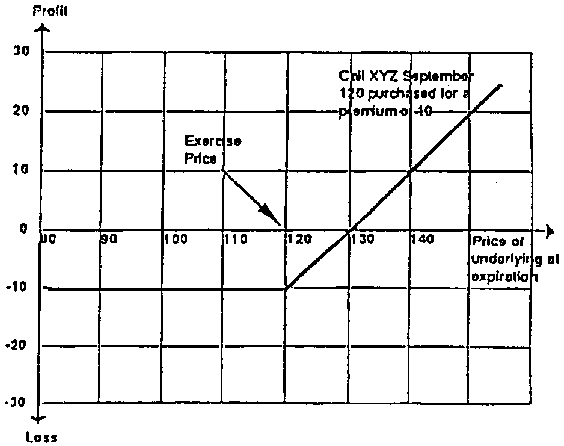
Profit/loss diagram for a short call
Profit/loss diagram for a long put
Profit/loss diagram for a short put
Summary - The four basic options positions
Characteristics of basic options positions
Expectations regarding the future price of the underlying:
|
|
Futures |
Call options |
Put options |
|
Bearish |
"Short" |
"Short" |
Long |
|
Bullish |
Long |
Long |
"Short" |
Profit and loss potential:
|
|
Long call |
Short call |
Long put |
Short put |
|
Profit potential |
Unlimited |
Limited |
Practically unlimited* |
Limited |
|
Loss potential |
Limited |
Unlimited |
Limited |
Practically unlimited* |
* In the case of the put we use the expression "practically unlimited" because the price of the underlying cannot fall below zero, which means that the profit/loss potential is limited although substantial.
Components of the option premium
|
Option premium = intrinsic value + time value |
Time value
The intrinsic value of an option is the profit the option holder would make if he decided to exercise his option immediately. It is always positive.
Call intrinsic value = Price of underlying - Exercise price (If the figure is positive. Should it be negative, the intrinsic value is equal to zero.)
Put intrinsic value = Exercise price - Price of underlying (If the figure is positive. Should it be negative, the intrinsic value is equal to zero.)
In-the-money
At-the-money
Out-of-the-money
An option is in-the-money if it has intrinsic value.
An option is at-the-money if the exercise price is equal to the price of the underlying. Intrinsic value is equal to zero.
An option is out-of-the-money if
(for a call) the exercise price is higher than the price of the underlying;
(for a put) the exercise price is lower than the price of the underlying.
|
|
Price of underlying lower than exercise price |
Price of underlying equal to exercise price |
Price of underlying higher than exercise price |
|
Call |
out-of-the-money |
at-the-money |
in-the-money |
|
Put |
in-the-money |
at-the-money |
out-of-the-money |
In-the-money
At-the-money
Out-of-the-money
CALL
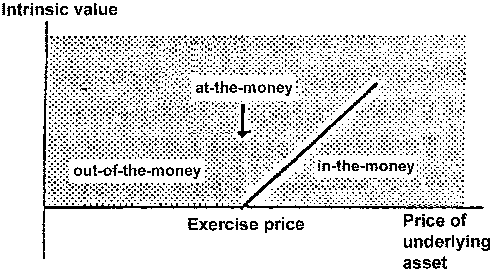
In-the-money
At-the-money
Out-of-the-money
Put
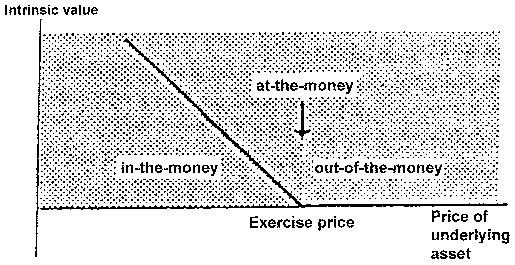
Time value
Option price - Intrinsic value = Time value
At expiration, the time value is necessarily equal to zero, i.e. the premium equals the option's intrinsic value.
The longer the time to expiration, the higher the time value. However, time is not the only factor affecting the time value of an option.
Time value
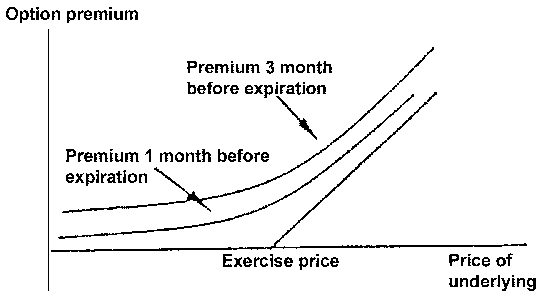
Factors influencing the option premium
1 - Time
2 - The price of the underlying asset
3 - The exercise price of the option
4 - Price volatility of the underlying asset
5 - Dividends/Yield
6 - The interest rate
Time
All other factors remaining equal, the value of an option is lower the closer the expiration date.
The loss of time value is faster as the expiration date approaches.
The price of underlying asset
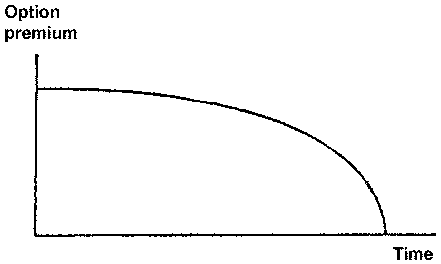
Call
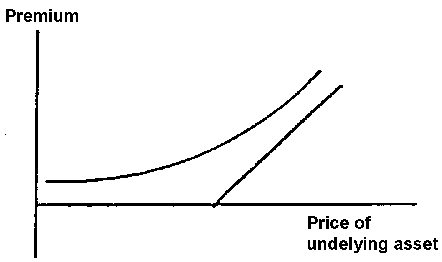
The higher the price of the underlying asset, the higher the option premium.
Put
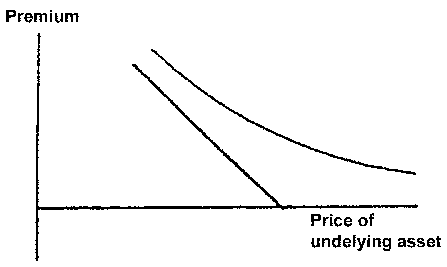
The higher the price of the underlying asset, the lower the option premium.
The more the options is in-the-money or out-of-the-money, the lower is its time value; i.e. the option premium is close to the intrinsic value of the option.
Exercise price - Call
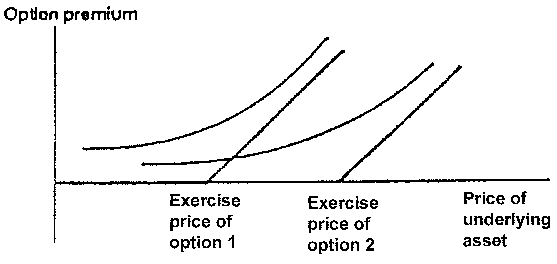
Comparing two calls with the same underlying asset; the higher the exercise price of a call, the lower its premium.
Put

Comparing two puts with the same underlying asset; the higher the exercise price of a put, the higher its premium.
Volatility of the underlying asset
The higher the price volatility of the underlying asset, the higher the likelihood that the option will end up in-the-money; therefore, the higher the premium.
Call
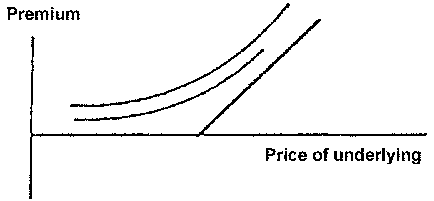
Put
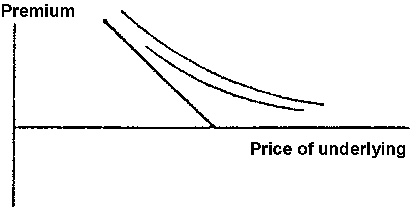
Interest rate
The higher the "riskless interest rate", the higher the call premium.
The higher the "riskless interest rate", the lower the put premium.
(The impact of day-to-day interest rate fluctuation can be neglected for practical purposes.)
Summary - Factors affecting the option premium
|
|
Call premium |
Put premium |
|
Longer time to expiration |
+ |
+ |
|
Higher price of underlying |
+ |
- |
|
Higher volatility of underlying |
+ |
+ |
|
Higher exercise price |
- |
+ |
|
Higher interest rate |
+ |
- |
|
Dividend |
- |
+ |
Examples of coffee, sugar and cotton options*
Source: Futures and Options World, Chicago, October 1988.
|
|
Lifetime |
Open |
||||||
|
|
Open |
High |
Low |
Settle |
Change |
High |
Low |
Interest |
|
COFFEE (CSCE) - 37,500 lbs.; cents per lb. |
||||||||
|
Dec |
126.25 |
127.0 |
125.86 |
126.98 |
+0.85 |
150.25 |
101.00 |
7,467 |
|
Mr 89 |
126.00 |
126.90 |
125.70 |
126.80 |
+0.62 |
150.50 |
112.44 |
8,684 |
|
May |
125.43 |
125.95 |
125.40 |
125.77 |
-0.16 |
150.75 |
112.13 |
2.132 |
|
July |
124.70 |
125.70 |
124.70 |
125.28 |
+0.52 |
145.00 |
114.00 |
1,275 |
|
Sept |
... |
... |
... |
125.13 |
+0.88 |
143.50 |
114.00 |
520 |
|
Dec |
... |
... |
... |
123.50 |
-1.51 |
129.25 |
118.00 |
105 |
Est vol 2,760; vol Tues 5,434; open int 20,183, -319.
|
|
Lifetime |
Open |
||||||
|
|
Open |
High |
Low |
Settle |
Change |
High |
Low |
Interest |
|
SUGAR - WORLD (CSCE) - 112,000 lbs.; cents per lb. |
||||||||
|
Jan |
... |
... |
... |
9.90 |
+0.10 |
15.00 |
7.75 |
102 |
|
Mar |
10.10 |
10.38 |
10.07 |
10.36 |
+0.25 |
14.39 |
7.66 |
73,216 |
|
May |
9,83 |
10.12 |
9.81 |
10.12 |
+0.25 |
13.64 |
7.87 |
24,686 |
|
July |
9.68 |
9.93 |
9.66 |
9.92 |
+0.21 |
13.40 |
8.10 |
6,678 |
|
Oct |
9.54 |
9.79 |
9.53 |
9.79 |
+0.24 |
13.30 |
8.45 |
9,897 |
|
Mr 90 |
9.29 |
9.38 |
9.29 |
9.42 |
+0.17 |
9.70 |
8.75 |
259 |
Est vol 10,152; vol Tues 6,332; open int 114,852, -451.
|
|
Lifetime |
Open |
||||||
|
|
Open |
High |
Low |
Settle |
Change |
High |
Low |
Interest |
|
SUGAR - DOMESTIC (CSCE) - 112,000 lbs.; cents per lb. |
||||||||
|
Ja 89 |
21.60 |
21.60 |
21.60 |
21.60 |
... |
22.44 |
21.59 |
2,061 |
|
Mar |
21.80 |
21.80 |
21.79 |
21.80 |
-0.01 |
22.50 |
21.75 |
1,952 |
|
May |
... |
... |
... |
21.97 |
-0.01 |
22.60 |
21.80 |
1,275 |
|
July |
22.01 |
22.01 |
22.01 |
22.01 |
... |
22.60 |
21.80 |
777 |
|
Sept |
22.00 |
22.00 |
22.00 |
22.00 |
+0.01 |
22.60 |
21.95 |
1,130 |
|
Nov |
... |
... |
... |
21.81 |
-0.08 |
22.50 |
21.62 |
379 |
Est vol. 78; vol Tues 287; open int 7.574, +64.
|
|
Lifetime |
Open |
||||||
|
|
Open |
High |
Low |
Settle |
Change |
High |
Low |
Interest |
|
COTTON (CTN) - 50,000 lbs.; cents per lb. |
||||||||
|
Dec |
54.92 |
55.29 |
54.65 |
55.16 |
+0.20 |
70.20 |
48.65 |
12,475 |
|
Mr 89 |
55.35 |
55.80 |
55.16 |
55.75 |
+0.35 |
68.90 |
48.90 |
12,557 |
|
May |
55.40 |
55.95 |
55.30 |
55.87 |
+0.27 |
68.70 |
49.03 |
3,452 |
|
July |
55.65 |
56.10 |
55.46 |
55.85 |
+0.10 |
65.73 |
49.26 |
3,103 |
|
Oct |
55.90 |
55.90 |
55.65 |
55.90 |
+0.45 |
65.50 |
50.35 |
902 |
|
Dec |
55.80 |
56.15 |
55.62 |
56.07 |
+0.52 |
65.50 |
50.75 |
3,355 |
Est vol 5,000; vol Tues 5,051; open int 35,876, -698.
Examples of gold and silver futures options*
Source: Futures and Options World, Chicago, October 1988.
GOLD (EOE) - 10 troy ounces, dollars per troy ounce)
|
Strike |
Calls - Last |
Puts - Last | ||||
|
Price |
Nov |
Feb |
May |
Nov |
Feb |
May |
|
390 |
32.50 |
42.00 |
52.00 |
0.30 |
2.50 |
5.50 |
|
400 |
23.00 |
34.00 |
43.00 |
0.80 |
4.50 |
7.00 |
|
420 |
4.00 |
17.80 |
30.00 |
4.00 |
9.50 |
13.00 |
|
440 |
0.20 |
8.00 |
18.00 |
22.00 |
22.00 |
23.00 |
|
460 |
0.40 |
5.00 |
10.00 |
42.00 |
42.00 |
42.00 |
|
Call volume: 325 contracts |
|
Call open interest: 21170 | ||||
|
Put volume: 35 contracts |
|
Put open interest: 12489 | ||||
SILVER (EOE) - 250 troy ounces, cents per troy ounce)
|
Strike |
Calls - Last |
Puts - Last | ||||
|
Price |
Dec |
Mar |
Jun |
Dec |
Mar |
Jun |
|
550 |
110 |
125 |
140 |
5 |
10 |
10 |
|
600 |
60 |
75 |
100 |
10 |
20 |
25 |
|
650 |
30 |
55 |
65 |
35 |
45 |
50 |
|
700 |
14 |
30 |
50 |
75 |
75 |
80 |
|
750 |
12 |
25 |
40 |
125 |
125 |
130 |
|
Call volume: 0 contracts |
|
Call open interest: 1939 | ||||
|
Put volume: 0 contracts |
|
Put open interest: 934 | ||||
GOLD (CMX) 100 troy ounces; dollars per troy ounce
|
Strike |
Calls - Last |
Puts - Last |
||||
|
Price |
Dec-c |
Feb-c |
Apr-c |
Dec-p |
Feb-p |
Apr-p |
|
400 |
24.80 |
31.00 |
37.70 |
0.10 |
2.20 |
4.10 |
|
410 |
14.80 |
23.30 |
29.90 |
0.10 |
3.60 |
5.90 |
|
420 |
5.70 |
15.30 |
22.70 |
1.00 |
5.80 |
8.30 |
|
430 |
0.90 |
10.00 |
16.50 |
6.20 |
10.00 |
11.70 |
|
440 |
0.20 |
5.90 |
12.10 |
15.50 |
15.40 |
16.60 |
|
450 |
0.10 |
3.70 |
8.60 |
25.40 |
22.90 |
23.00 |
|
Est. vol. 4,000, Tues vol. 2,305 calls, 2,116 puts |
|
|||||
|
Open interest Tues; 67,608 calls, 50,952 puts |
|
|||||
SILVER (CMX) 5,000 troy ounces; cents per troy ounce
|
Strike |
Calls - Last |
Puts - Last |
||||
|
Price |
Dec-c |
Mar-c |
May-c |
Dec-p |
Mar-p |
May-p |
|
600 |
58.0 |
77.5 |
92.0 |
0.1 |
5.5 |
11.5 |
|
625 |
33.5 |
59.0 |
74.0 |
0.5 |
11.0 |
18.0 |
|
650 |
11.0 |
42.0 |
59.0 |
3.0 |
19.0 |
27.0 |
|
675 |
1.7 |
33.0 |
49.0 |
18.5 |
34.5 |
41.0 |
|
700 |
0.9 |
25.5 |
40.0 |
43.0 |
51.5 |
57.0 |
|
725 |
0.2 |
19.0 |
33.0 |
67.0 |
70.0 |
75.0 |
|
Est. vol. 3.000, Tues vol. 2.099 calls. 721 puts |
|
|||||
|
Open interest Tues; 49,406 calls, 15,620 puts |
|
|||||
Examples of futures and options quotations
|
FUTURES |
size |
tick size |
months |
hours |
delivery |
|
US Dollar Index |
$500 x index |
$ 5.00 |
Mar Jun Sep Dec |
8.20-14.40 |
c |
|
Ecu |
Ecu 100,000 |
$10.00 |
Mar Jun Sep Dec |
8.20-14.40 |
p |
|
Five Year US Treasury notes |
$100,000 |
$15,625 |
Mar Jun Sep Dec |
8.20-15.00 |
p |
|
Cotton |
50,000 lbs |
$ 5.00 |
Mar May Jul Oct Dec |
10.30-15.00 |
p |
|
Orange juice |
15,000 lbs |
$ 7.50 |
Jan Mar May Jul Sep Nov |
10.15-14.45 |
p |
|
OPTIONS | |||||
|
Cotton |
50.000 lbs |
$ 5.00 |
Mar May Jul Oct Dec |
10.30-15.00 |
f |
|
Orange juice |
15,000 lbs |
$ 7,50 |
Jan Mar May Jul Sep Nov |
10.45-14.45 |
f |
|
US Dollar Index |
$500 x index |
$ 5.00 |
Mar Jun Sep Dec |
8.20-14.40 |
f |
|
Five Year US Treasury notes |
$100,000 |
$15,625 |
Mar Jun Sep Dec |
8.20-15.00 |
f |
All NYCE's financial contracts are traded on Finex, the exchange's financial instruments subsidiary.
Source: New York Cotton Exchange.